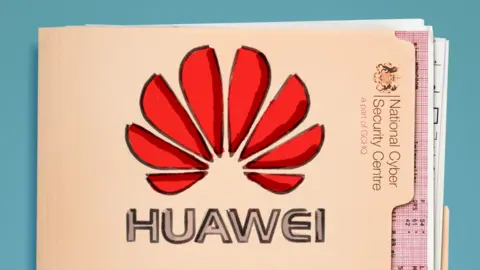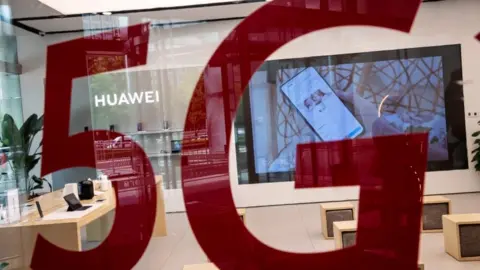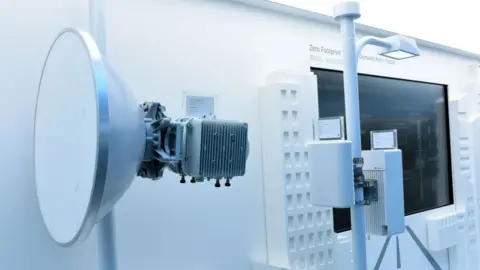Why Huawei's days in the UK could be numbered
 BBC
BBCThe UK government is inching towards taking a decision on Huawei's role in the UK's 5G and fixed-broadband networks.
The National Cyber Security Centre (NCSC) - a branch of the intelligence service GCHQ - has documented all the facts ahead of giving its view.
And civil servants at the Department for Digital, Culture, Media and Sport (DCMS) are weighing up the financial consequences of ordering a ban or new limits.
In theory, a decision could come as soon as next week but it is likely to take a bit longer.
Those following developments would be forgiven for having a sense of deja vu.
It was only in January that the UK government announced, following a lengthy review, that the Chinese firm could continue to provide equipment and expertise to the UK networks, albeit with a new cap on its market share.
Washington has continued to assert that Huawei poses a national security risk - most recently claiming it is either backed or owned by the Chinese military - something the firm denies.
 Getty Images
Getty ImagesBut it is not this, but rather the threat of new US sanctions, that might change the UK's course.
The sanctions threaten Huawei's ability to provide the behind-the-scenes kit that transmits data back and forth, as well as its ability to make the handsets and other consumer goods for which it is renowned.
To understand why, one needs to become acquainted with a little-reported side to the tech industry.
Simulated chips
When Huawei announced its flagship Kirin 990 5G chip last year, it boasted "over 10 billion transistors are condensed in this tiny chipset".
The reason such intricate products can be made is that the days of laying out such chips by hand have long passed.
Instead, the semiconductor industry relies on a type of software known as electronic design automation (EDA).
 Huawei
Huawei"It's theoretically possible to manually design today's chips, but it's extremely difficult and would take a long time," explains Jim Tully, an independent industry analyst.
"Instead, automated software is used to help with the physical layout of the chip, but also to design its logical functionality - its arrays of memory cells and microprocessor cores, its ability to compress the signals and also to carry out special functions for the inputs and the outputs of a chip.
"And the software is also used to simulate the chip working, because once you put it into the manufacturing process it is extremely expensive."
In practice, humans carry out the design work by describing the behaviours they want in computer code, and the software then translates this into a physical design.
The problem for Huawei is that the three leading EDA software-makers all have ties to the US. And the sanctions forbid the Chinese firm and the third parties that manufacture its chips from using "US technology and software to design and manufacture" its products.
Synopsys and Cadence are both based in California. And while Germany's Siemens bought Mentor Graphics in 2017, it still has its headquarters in Wilsonville, Oregon.
Even if Huawei could get round this, the sanctions also ban fabricators from using semiconductor manufacturing equipment based on US tech.
That effectively locks Huawei out from the equipment needed to print the smallest-sized transistors currently possible, which in turn limits how efficiently its products can run.
 Getty Images
Getty ImagesSo, while Huawei could try to skirt round the sanctions by shifting its business to China's predominant foundry - Shanghai-based Semiconductor Manufacturing International Corp (SMIC) - that company, too, needs to obey the US rules or would face consequences of its own that might threaten its wider business.
Trying to survive
There have been reports that Huawei hopes to weather the storm by drawing on a stockpile of chips it has built up before the sanctions bite.
Earlier this month, the Financial Times reported Huawei had secured up to two years of supplies of the "most essential components" it needs to continue making mobile-tower base stations and cloud computer servers.
But UK ministers may decide that it is just too risky for the country's telecoms infrastructure to be reliant on a company that might not be able to provide its own components and would have to fall back on others from as yet unknown suppliers.
And looking more widely, Huawei may find it impossible to keep driving forward its smartphone photography and other consumer-focused innovations if it cannot equip its devices with next-generation processors.
When the sanctions were first announced, one of Huawei's chiefs suggested they posed an existential threat.
"Survival is the keyword for us now," said one of its chairmen, Guo Ping.
The US still has time to back away from the measures before they are due to come into full effect in September.
And in the past Washington has granted licences to some US firms excluding them from previous bans.
Even so, if the UK government is looking for a reason to revisit January's decision - perhaps to help secure a US trade deal or prevent a backbench revolt - the arcane world of chip design might provide the solution.


The mood music has changed dramatically since January.
That decision was already hard-fought, with opposition in the cabinet to giving Huawei a role in 5G. But since then, the US has intensified its campaign, not just with the sanctions but also warnings about intelligence sharing and defence relationships.
At the same time, the mood politically in Westminster has shifted with a significant backbench rebellion in March now spurred on by the coronavirus crisis which has highlighted dependencies on China.
All of that means a change may well be coming in the UK approach, but the exact nature of it remains unclear.

